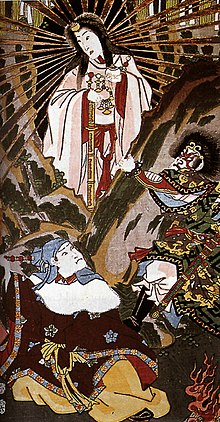
Back أماتيراسو Arabic Amaterasu Azerbaijani Amaterasu BCL Аматэрасу Byelorussian Аматэрасу BE-X-OLD Amatérasu BEW Аматерасу Bulgarian Amaterasu Catalan Amaterasu Czech Amaterasu Danish
| Amaterasu | |
|---|---|
 Amaterasu emerging from the cave, Ama-no-Iwato, to which she once retreated (detail of woodblock print by Kunisada) | |
| Other names |
|
| Planet | Sun |
| Texts | Kojiki, Nihon Shoki, Sendai Kuji Hongi |
| Genealogy | |
| Parents |
|
| Siblings | |
| Consort |
|
| Children | |
Amaterasu Ōmikami (天照大御神, 天照大神), often called Amaterasu for short, also known as Ōhirume no Muchi no Kami (大日孁貴神), is the goddess of the sun in Japanese mythology. Often considered the chief deity (kami) of the Shinto pantheon,[2][3][4] she is also portrayed in Japan's earliest literary texts, the Kojiki (c. 712 CE) and the Nihon Shoki (720 CE), as the ruler (or one of the rulers) of the heavenly realm Takamagahara and as the mythical ancestress of the Imperial House of Japan via her grandson Ninigi. Along with two of her siblings (the moon deity Tsukuyomi and the impetuous storm-god Susanoo) she ranks as one of the "Three Precious Children" (三貴子, mihashira no uzu no miko / sankishi), the three most important offspring of the creator god Izanagi.
Amaterasu's chief place of worship, the Grand Shrine of Ise in Ise, Mie Prefecture, is one of Shinto's holiest sites and a major pilgrimage center and tourist spot. As with other Shinto kami, she is also enshrined in a number of Shinto shrines throughout Japan.
- ^ Kawamura (2013-12-19). Sociology & Society Of Japan. Routledge. p. 205. ISBN 978-1-317-79319-9.
- ^ Varley, Paul (1 March 2000). Japanese Culture. University of Hawaii Press. p. 8. ISBN 978-0-8248-6308-1. Retrieved 1 January 2024.
- ^ Narayanan, Vasudha (2005). Eastern Religions: Origins, Beliefs, Practices, Holy Texts, Sacred Places. Oxford University Press. p. 440. ISBN 978-0-19-522191-6. Retrieved 1 January 2024.
- ^ Zhong, Yijiang (6 October 2016). The Origin of Modern Shinto in Japan: The Vanquished Gods of Izumo. Bloomsbury Publishing. pp. 2, 3. ISBN 978-1-4742-7110-3. Retrieved 1 January 2024.